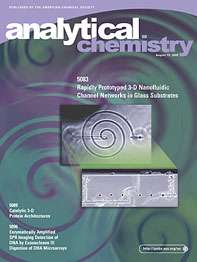Drilling tiny tunnels gets easier in a big way

The counterintuitive rules of physics at the nanometer scale create several thorny problems for scientists when they try to fashion three-dimensional channels in fluid-handling devices.
Now, University of Michigan researchers think they’ve solved at least one of these problems of micro- and nano-fluidic devices by developing a way to push debris out of the way as they machine tiny tunnels.
Using ultra-fast pulsed lasers to cut materials submersed in fluids, the researchers have made three-dimensional microfluidic devices laced with tiny tunnels, less than a micrometer in diameter, that form completely clear of debris. The new process can be performed in glass and other hard materials, making them a suitable substitute for the soft materials commonly used in microfluidics, which have many shortcomings, such as lack of solvent resistance, protein attachment, leaching, and inability to withstand high pressures.
Removal of debris has been a substantial challenge for machining micro and nanofluidic devices. It is very difficult to remove debris mechanically in a twisting nano-scale tunnel, and chemical etching processes can alter the shapes of the channels in undesirable ways, said Alan Hunt, associate professor of biomedical engineering.
Hunt and Earnest Hasselbrink, assistant professor of mechanical engineering and graduate student Kevin Ke, have described their new process in “Rapidly Prototyped Three Dimensional Nanofluidic Channel Networks in Glass Substrates,” a paper in the journal Analytical Chemistry earlier this month. The paper appeared as an editor’s choice in the journal Science on July 29.
The team has been making tunnels using a method of nanoscale machining developed at U-M which uses short laser blasts to ablate or drill into the glass. The laser beam is tightly focused to form a cone of light that passes through the surface of the glass, and only cuts below the surface where the beam converges to a focus. The material’s surface remains unchanged. But debris in the newly-drilled channels remained a problem.
Luck, good timing, and an elevator ride provided the researchers with the breakthrough they needed to get debris out of the tunnels, Hasselbrink said.
Hasselbrink and Hunt were discussing the problem of debris deposition on the surface of materials in the elevator when colleague Professor Edgar Meyhöfer casually suggested they try covering the glass with water before cutting it with the laser. It worked.
“What was initially mysterious was why the tunnels contained no machining debris” said Hunt. Further investigation revealed that the drilling caused bubbles that pushed the debris through the tunnel and out the mouth, where the bubbles dissipated. In traditional laser machining, such bubbles could cause damage to the inside of the tunnel, but because the physical behavior of bubbles is different during nanoscale machining, they do not, Hunt said.
The ability to make these small devices with tunnels at different depths allows fluid streams to cross without mixing, and enables scientists to pack more components into a small area.
The new machining method could create very small, complex, rapid analytical devices inexpensively for testing new pharmaceutical compounds or quickly diagnosing diseases. Commercialization opportunities are being actively pursued in collaboration with the U-M’s office of Technology Transfer.
Source: University of Michigan


















